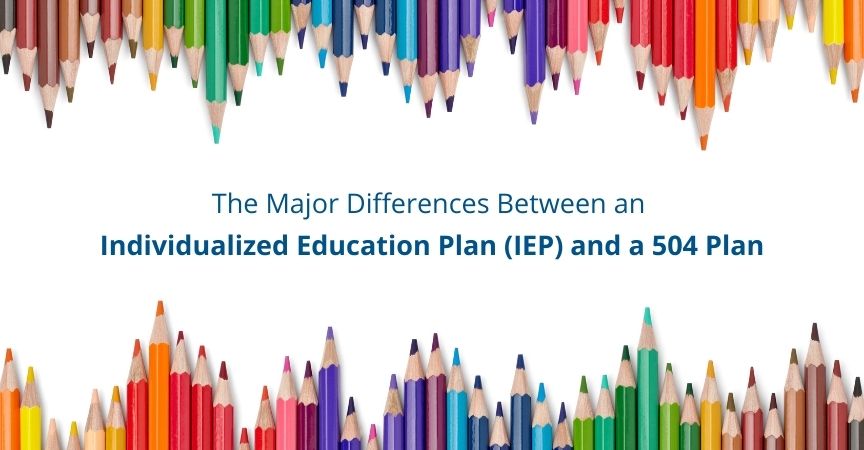When parents of children with special needs encounter the public school system for the first time, they often have questions about the kinds of assistance and services that will be available to their children.
Under the Individuals with Disabilities Education Act (IDEA), all students ages three and up are entitled to a Free and Appropriate Education (FAPE) in the U.S. school system. A number of different options should be available to your family, and your child’s placement in these programs will depend on the nature of their disability.
Two of the most common services you’ll see are the IEP and the 504 plan. Both of these programs provide accommodations to children with special needs, and both are available free of charge to families that qualify. However, there are some important differences between the two to note.
The IEP
An IEP, or Individualized Education Plan, is a written plan that outlines any special education-related services and strategies that will support your child’s education. In essence, it is a roadmap for how the school will accommodate your child’s disability while also providing an education in the least restrictive environment.
The IEP is developed by the child’s school and parents or guardian, and normally covers general education, extracurricular activities, and nonacademic activities. All students receiving special education services are entitled to have their curriculum and classroom experience modified if need be in order to accommodate their disability. They are also entitled to specialized instructions and related services like occupational therapy, physical therapy, speech therapy, and counseling. All of these things are accounted for in the IEP plan.
The main purpose of the IEP is to set measurable goals for the child to ensure they are receiving a free and appropriate education along with any additional services or accommodations they might need based on their disability. By law, the IEP is reviewed annually and the student is re-evaluated every three years to determine continued eligibility. A parent can also request re-evaluation sooner, though not less than one year after.
Children ages three and up who attend public school, including charter schools, are eligible for an IEP if they have one or more of the 13 conditions covered under IDEA. Eligibility is also determined by whether the child needs special services like assistive technology or time in the resource room to both function and thrive at school.
The 504 Plan
A 504 plan, named for Section 504 of the Rehabilitation act of 1973, is for children with a diagnosis of a physical or emotional disability who do not qualify for special education but still require accommodations in the classroom.
Some examples of children eligible for a 504 plan include those with attention deficit and hyperactivity disorder (ADHD), short-term disabilities, and conditions like diabetes or asthma.
504 plans are designed to enable the student to learn in the regular classroom, rather than a separate, special education one. The plan can provide extended time or small group administration for statewide testing, and it can allow for accommodations like frequent breaks during instruction or modified homework assignments.
Note that a student is not able to receive specialized instruction or related services, such as occupational therapy, speech therapy or physical therapy, through a 504 Accommodation Plan. And unlike an IEP, there is no legal requirement to review a 504 plan each year. It does, however, require periodic review usually around every three years. We do suggest revisiting the plan annually to make sure it is still working for your child.
Key Differences
One of the biggest differences between these two plans is around eligibility. To receive a 504 plan, a child need only have a disability that somewhat interferes with their learning. To get an IEP, the child must have one or more of the 13 specific disabilities covered by IDEA. These disabilities are generally considered permanent in nature, whereas those covered under 504 plans can be both permanent and temporary conditions.
Unlike an IEP, a 504 plan does not have to be a written document. It will usually include the specific accommodations a child will receive as well as who will administer and monitor them, and does require documentation of evaluations and accommodations. In contrast, an IEP sets specific goals, timing of services, and information around how the child will participate in general education. The IEP is far more comprehensive than a 504 plan.
In both cases, eligible children have a right to these programs, and school districts are required by law to provide them.
The Law Office of Jennifer Chang believes in protecting students’ rights to a free and appropriate education under both federal and state laws. If your child is eligible to receive special education and is not getting the appropriate services or accommodations, Jennifer Chang, education rights attorney will fight vigorously on your family’s behalf. Please reach out to her today or call (323) 931-5270 to discuss your case.
